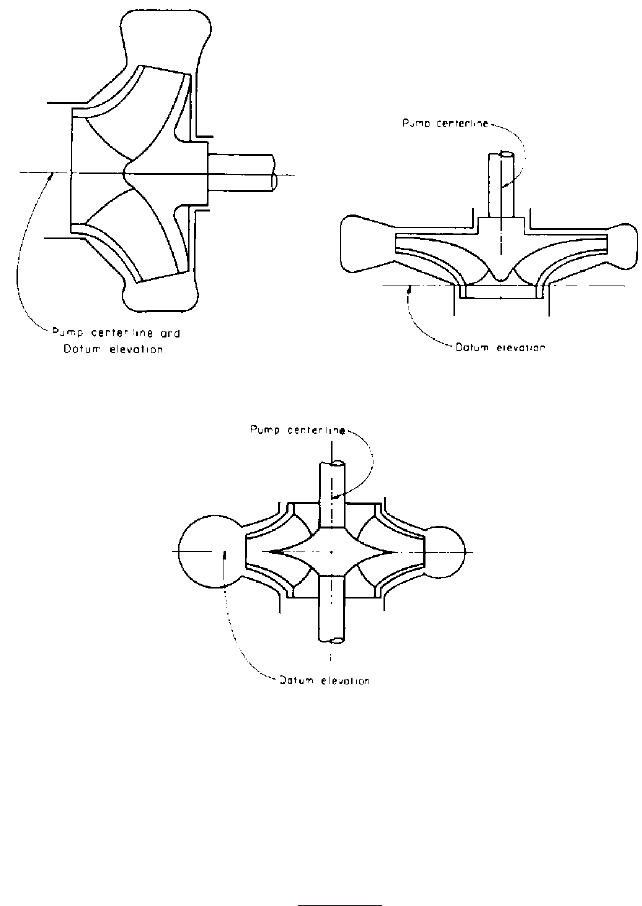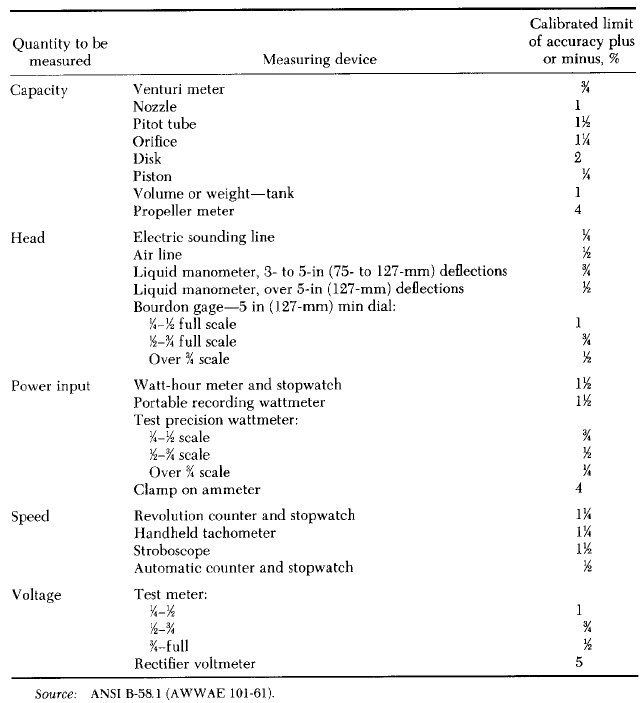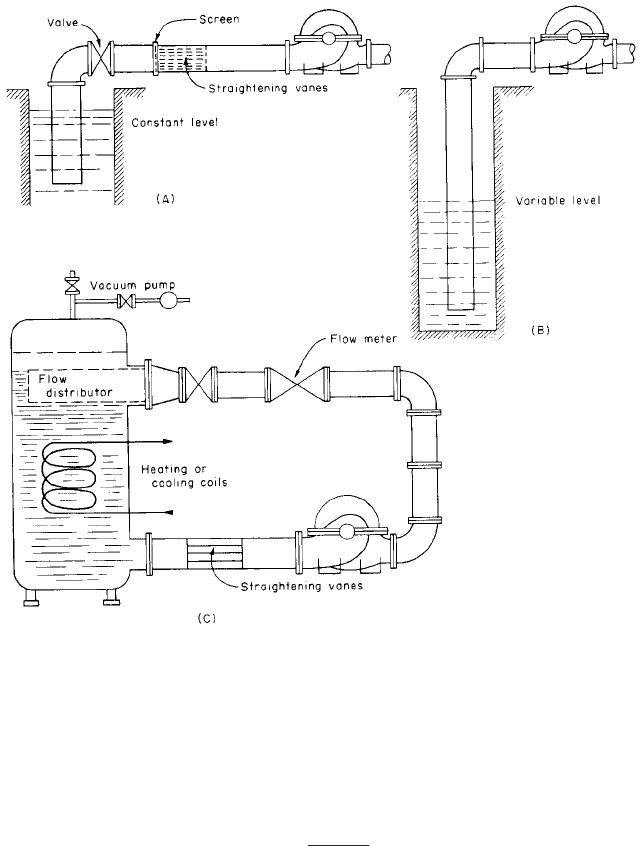Pump Handbook by Igor J. Karassik, Joseph P. Messina, Paul Cooper, Charles C. Heald - 3rd edition
Подождите немного. Документ загружается.


Pump
Testing
Wesley W. Beck
C•H•A•P•T•E•R•13
13.2 CHAPTER THIRTEEN
Since the first time a device was used to pump or lift water, pump testing of one sort or
another has occurred. Each improvement in pumping devices was accepted only after
being tested, which was the proof of its worthiness. As pumping equipment has become
more refined, so has the art of pump testing, both in the shop or laboratory and in the field.
For very large pumps, model testing is being used to develop the optimum refinement in
prototype design.
Every pump, regardless of size or classification, should be tested in some way before
final acceptance by the purchaser. If not, the user does not have any way of knowing that
all requirements have been fulfilled. What tests to run and what methods to use depend
on the ultimate purpose of the tests, which normally have one of two objectives:
1. To check improvement in design or operation
2. To determine if contractual commitments have been met, thus making possible the
comparison of specified, predicted, and actual performance
In most cases, the manufacturer supplies a test report and certifies the characteristics
of the pump being furnished. Even these can be given a cursory check by the customer
from time to time to give a record of performance or an indication of the need for replace-
ment or overhaul. If at all possible, the pump should be tested as installed, with repeat
tests from time to time to check operation.
The main object of this chapter is to present a set of procedures and rules for conduct-
ing, computing, and reporting on tests of pumping units and for obtaining the head, capac-
ity, power, efficiency, and suction requirements of a pump.
CLASSIFICATION OF TESTS ___________________________________________
Pump tests should be classified as follows:
• Shop tests are also called laboratory, manufacturer’s, or factory acceptance tests. They
are conducted in the pump manufacturer’s plant under geometrically similar, ideal,
and controlled conditions and are usually assumed to be the most accurate tests.
• Field tests are made with the pumping unit installed in its exact environment and
operating under existing field or ultimate conditions. The accuracy and reliability
of field testing depend on the instrumentation used, installation, and advance
planning during the design stages of the installation. By mutual agreement, field
tests can be used as acceptance tests.
• Index tests are a form of field testing usually made to serve as a standard of
comparison for wear, changing conditions, or overhaul evaluation. Index tests should
always be run using the same procedures, instruments, and personnel where
possible, and a very accurate record and log of events should be kept to give as
complete and comparable a history of the results as possible.
• Model tests precede the design of the prototype and are usually quite accurate. They
supplement or complement field tests of the prototype for which the model was
made. The role of the model test must be clearly established as early in the design
as possible, preferably in the specification or invitation to bid. Model tests may be
used when very large units are involved, when the performances of several models
must be compared, and when an advance indication of prototype design is required.

13 PUMP TESTING 13.3
DEFINITIONS, SYMBOLS, AND UNITS ___________________________________
For a detailed discussion of letter symbols, definitions, description of terms, and table of
letter symbols in general use, the user is referred to ASME Power Test Code
1
and to “SI
Units
—
A Commentary” in front matter of this handbook.
Standard Units Used in Pump Testing The following definitions and quantities from
the Hydraulic Institute standards
2
are used throughout the industry in pump testing.
VOLUME The standard units of volume are the U.S. gallon and the cubic foot (cubic meter).
The standard U.S. gallon contains 231.0 in
3
(0.00379 m
3
), and 1 ft
3
7.4805 gal (0.028 m
3
).
Rate of flow is expressed in gallons per minute (cubic meters per hour), cubic feet per sec-
ond, or million gallons per 24-h day. The specific weight (mass) w of pure water at 68°F
(20°C), at sea level and 40° latitude, is 62.315 lb/ft
3
(0.998 kg/liter). For other tempera-
tures or locations, proper specific weight corrections should be made. See Table 1 and the
appropriate ASME power test codes.
HEAD The unit for measuring head is the foot (meter). The relation between a pressure
expressed in pounds per square inch (kilopascals) and one expressed in feet (meters) of
head is
in USCS units
in SI units
where w specific weight of liquid being pumped under pumping conditions, lb/ft
3
(kg/l)
All pressure readings must be converted to feet (meters) of the liquid being pumped,
referenced to a datum elevation, which is defined as follows. For a horizontal shaft unit, the
datum elevation is the centerline of the pump shaft (Figure 1). For vertical-shaft single-
suction pumps, it is the entrance eye to the first-stage impeller (Figure 2). For vertical-
shaft double-suction pumps, it is the impeller-discharge horizontal centerline (Figure 3).
VELOCITY HEAD The velocity head h
v
is computed from the average velocity V, obtained by
dividing the flow by the pipe cross-sectional area. Velocity head is determined at the point
of gage connection and is expressed by the formula
where V velocity in the pipe, ft/s (m/s)
g acceleration due to gravity 32.17 ft/s
2
(9.81 m/s
2
) (Table 2)
FLOODED SUCTION Flooded suction implies that the liquid must flow from an atmos-
pherically vented source to the pump without the average or minimum pressure at the
pump datum dropping below atmospheric pressure with the pump operating at specified
capacity.
TOTAL SUCTION LIFT Suction lift exists where the total suction head is below atmospheric
pressure. Total suction lift h
s
is the reading of a liquid manometer or pressure gage at the
suction nozzle of the pump, converted to feet (meters) of liquid, and referred to datum
minus the velocity head at the point of gage attachment.
TOTAL SUCTION HEAD Suction head exists when the total suction head h
s
is above atmos-
pheric pressure. Total suction head is the reading of a gage at the suction of the pump
converted to feet (meters) of liquid and referred to datum plus the velocity head at the
point of gage attachment.
h
v
V
2
2g
Head, m kPa
0.102
w
head, ft lb>in
2
144
w

13.4 CHAPTER THIRTEEN
TABLE 1 Specific weight of water in air
Temperature, °F (°C)
Latitude 32 (0) 40 (4.4) 50 (10) 60 (16) 70 (21) 80 (27) 90 (32) 100 (38)
At sea level
0° 62.1741 62.1823 62.1654 62.1227 62.0578 61.9729 61.8701 61.7514
10 62.1840 62.1921 62.1753 62.1325 62.0677 61.9828 61.8800 61.7612
20 62.2125 62.2206 62.2038 62.1610 62.0961 62.0112 61.9083 61.7895
30 62.2562 62.2643 62.2475 62.2046 62.1397 62.0547 61.9518 61.8328
40 62.3098 62.3179 62.3011 62.2582 62.1932 62.1082 62.0051 61.8861
50 62.3670 62.3751 62.3582 62.3153 62.2503 62.1652 62.0620 61.9429
60 62.4208 62.4289 62.4120 62.3691 62.3040 62.2188 62.1156 61.9963
70 62.4647 62.4728 62.4559 62.4130 62.3478 62.2626 62.1593 62.0399
At 2000 ft
0° 62.1665 62.1747 62.1578 62.1151 62.0502 61.9654 61.8626 61.7438
10 62.1764 62.1845 62.1677 62.1250 62.0601 61.9752 61.8724 61.7537
20 62.2049 62.2130 62.1962 62.1534 62.0885 62.0036 61.9008 61.7819
30 62.2486 62.2567 62.2399 62.1970 62.1321 62.0471 61.9442 61.8253
40 62.3022 62.3103 62.2935 62.2506 62.1856 62.1006 61.9976 61.8786
50 62.3594 62.3675 62.3506 62.3078 62.2427 62.1576 62.0545 61.9354
60 62.4132 62.4213 62.4044 62.3615 62.2964 62.2112 62.1080 61.9888
70 62.4571 62.4652 62.4484 62.4054 62.3402 62.2550 62.1517 62.0324
At 4000 ft
0° 62.1588 62.1669 62.1501 62.1073 62.0424 61.9576 61.8549 61.7361
10 62.1686 62.1767 62.1599 62.1172 62.0523 61.9675 61.8647 61.7459
20 62.1971 62.2052 62.1884 62.1456 62.0807 61.9959 61.8930 61.7742
30 62.2408 62.2489 62.2321 62.1893 62.1243 62.0394 61.9365 61.8176
40 62.2944 62.3025 62.2857 62.2428 62.1779 62.0929 61.9899 61.8709
50 62.3516 62.3597 62.3429 62.3000 62.2349 62.1498 62.0467 61.9277
60 62.4054 62.4135 62.3967 62.3537 62.2886 62.2035 62.1003 61.9811
70 62.4493 62.4574 62.4406 62.3976 62.3325 62.2472 62.1440 62.0247
At 6000 ft
0° 62.1508 62.1589 62.1421 62.0993 62.0345 61.9497 61.8469 61.7282
10 62.1607 62.1688 62.1520 62.1092 62.0444 61.9595 61.8568 61.7380
20 62.1891 62.1972 62.1804 62.1377 62.0728 61.9879 61.8851 61.7663
30 62.2328 62.2409 62.2241 62.1813 62.1164 62.0315 61.9286 61.8097
40 62.2864 62.2946 62.2777 62.2349 62.1699 62.0849 61.9819 61.8630
50 62.3436 62.3517 62.3349 62.2920 62.2270 62.1419 62.0388 61.9198
60 62.3974 62.4055 62.3887 62.3458 62.2807 62.1955 62.0924 61.9732
70 62.4413 62.4495 62.4326 62.3896 62.3245 62.2393 62.1361 61.0168
TOTAL DISCHARGE HEAD Total discharge head h
d
is the reading of a pressure gage at the
discharge of the pump, converted to feet (meters) of liquid and referred to datum plus the
velocity head at the point of gage attachment.
TOTAL HEAD
Total head H is the measure of the work increase per pound kilogram of liq-
uid, imparted to the liquid by the pump, and is therefore the algebraic difference between
the total discharge head and the total suction head. Total head, as determined on test
where suction lift exists, is the sum of the total discharge head and total suction lift.Where
positive suction head exists, the total head is the total discharge head minus the total suc-
tion head.

13 PUMP TESTING 13.5
TABLE 1 Continued.
Temperature, °F (°C)
Latitude 32 (0) 40 (4.4) 50 (10) 60 (16) 70 (21) 80 (27) 90 (32) 100 (38)
At 8000 ft
0° 62.1426 62.1507 62.1339 62.0912 62.0264 61.9416 61.8388 61.7201
10 62.1525 62.1606 62.1438 62.1011 62.0362 61.9514 61.8487 61.7300
20 62.1810 62.1891 62.1723 62.1295 62.0646 61.9798 61.8770 61.7582
30 62.2246 62.2328 62.2159 62.1731 62.1082 62.0233 61.9205 61.8016
40 62.2783 62.2864 62.2696 62.2267 62.1618 62.0768 61.9738 61.8549
50 62.3354 62.3436 62.3267 62.2838 62.2188 62.1338 62.0307 61.9117
60 62.3893 62.3974 62.3805 62.3376 62.2725 62.1874 62.0843 61.9651
70 62.4332 62.4413 62.4244 62.3815 62.3164 62.2312 62.1280 62.0087
At 10,000 ft
0° 62.1343 62.1424 62.1256 62.0828 62.0180 61.9333 61.8305 61.7119
10 62.1442 62.1523 62.1355 62.0927 62.0279 61.9431 61.8404 61.7217
20 62.1726 62.1807 62.1639 62.1212 62.0563 61.9715 61.8687 61.7500
30 62.2163 62.2244 62.2076 62.1648 62.0999 62.0150 61.9122 61.7934
40 62.2699 62.2781 62.2612 62.2184 62.1534 62.0685 61.9656 61.8466
50 62.3271 62.3352 62.3184 62.2755 62.2105 62.1255 62.0224 61.9034
60 62.3809 62.3890 62.3722 62.3293 62.2642 62.1791 62.0760 61.9568
70 62.4248 62.4330 62.4161 62.3732 62.3080 62.2229 62.1197 62.0005
At 12,000 ft
0° 62.1258 62.1339 62.1171 62.0743 62.0095 61.9248 61.8221 61.7035
10 62.1357 62.1438 62.1270 62.0842 62.0194 61.9347 61.8319 61.7133
20 62.1641 62.1722 62.1554 62.1127 62.0478 61.9630 61.8603 61.7416
30 62.2078 62.2159 62.1991 62.1563 62.0914 62.0066 61.9037 61.7849
40 62.2614 62.2695 62.2527 62.2099 62.1450 62.0600 61.9571 61.8382
50 62.3186 62.3267 62.3099 62.2670 62.2020 62.1170 62.0140 61.8950
60 62.3724 62.3805 62.3637 62.3208 62.2557 62.1706 62.0675 61.9484
70 62.4163 62.4245 62.4076 62.3647 62.2996 62.2144 62.1112 61.9920
Note: All values are in pounds per cubic foot, 1 lb/ft
3
16 kg/m
3
; 1 ft 0.048 m.
Density of water from Source 1, p. 296
Gravity formula from Source 4, p. 488
G
0/
980.616 (1 0.0026373 cos 20/ 0.0000059 cos
2
20/)
Altitude correction 0.0003086 altitude in meters.
Standard gravity 980.665 cm/s
2
Density of air from Source 2:
Density 0.001225(1 0.0065H 0288.16)
4.2561
where H is in meters
Sources:
1. Smithsonian Physical Tables, 9th rev. ed.
2. National Advisory Committee for Aeronautics, TN 3182.
3. American Society of Mechanical Engineers, PTC 2-1971.
4. Smithsonian Meteorological Tables, 6th rev. ed.
NET POSITIVE SUCTION HEAD
The net positive suction head (NPSH) h
sv
is the total suction
head in feet (meters) of liquid absolute determined at the suction nozzle and referred to
datum less the vapor pressure of the liquid in feet (meters) absolute.
DRIVER INPUT The driver input ehp is the input to the driver expressed in horsepower
(kilowatts). Usually this is electric input horsepower (kilowatts).

13.6 CHAPTER THIRTEEN
FIGURE 1 Horizontal pump
FIGURE 2 Vertical single-suction pump
FIGURE 3 Vertical double-suction pump
PUMP INPUT
Pump input bhp is the power delivered to the pump shaft and is designated
as brake horsepower (brake kilowatts).
LIQUID OR WATER POWER Water power whp (wkW) is the useful work delivered by the pump
and is usually expressed by the formula
in USCS units
in SI units
where sp. gr. specific gravity of liquid, referred to water at 68°F (20°C)
Q flow rate, gpm(m
3
/h)
H total head, ft (m)
wkW 9.8QH1sp. gr.2
whp
1sp. gr.2QH
3960

13 PUMP TESTING 13.7
TABLE 2 Variation of acceleration of gravity with latitude and altitude
Altitude above mean sea level, ft
Latitude 0 2000 4000 6000 8000 10,000 12,000
0° 32.0878 32.0816 32.0754 32.0693 32.0631 32.0569 32.0508
10 32.0929 32.0867 32.0805 32.0744 32.0682 32.0620 32.0558
20 32.1076 32.1014 32.0952 32.0890 32.0829 32.0767 32.0705
30 32.1301 32.1239 32.1177 32.1115 32.1054 32.0992 32.0930
40 32.1577 32.1515 32.1454 32.1392 32.1330 32.1269 32.1207
50 32.1872 32.1810 32.1748 32.1687 32.1625 32.1563 32.1501
60 32.2149 32.2087 32.2026 32.1964 32.1902 32.1841 32.1779
70 32.2375 32.2314 32.2252 32.2190 32.2129 32.2067 32.2005
Note: All values are in feet per second per second; 1 ft/s
2
0.3048 m/s
2
; 1 ft 0.3048 m
Gravity 980.616 (1 0.0026373 cos 20/ 0.0000059 cos
2
20)(1.0/30.48)
Correction for altitude 0.003086 ft/s
2
/1,000 ft
The international standard value of gravity adopted by the International Commission on Weights
and Measures is 980.665 cm/s
2
(32.17405 ft/s
2
) at sea level and approximately latitude 45°.
Sample Computation
Given:
Altitude 12,000 ft (3657.60 m)
Latitude 70°
Water temperature 40°F (4.4°C)
Altitude correction for gravity:
0.0003086 3657.60 1.128785 cm/s
2
Gravity corrected for latitude and altitude:
Gravity 980.616 (1 0.0026373 cos 140° 0.0000059 cos
2
140°) 1.128735 981.471784 cm/s
2
Density corrected for gravity:
Density (0.9999988 981.471784/980.6650 1.000028) 1.0007930 g/cm
3
Correcting for buoyancy of air:
Density 1.0007930 0.0008491 0.9999438 g/cm
3
Density in USCS units:
Density 0.9999438 62.4279606 62.4244543 lb/ft
3
Sources:
1. “Smithsonian Physical Tables,” 9th Rev. Ed.
2. American Society of Mechanical Engineers, PTC 2
—
1971
This formula is derived on p. 13.36.
EFFICIENCY Pump efficiency E
p
is the ratio of the power delivered by the pump to the
power supplied to the pump shaft; that is, the ratio of the liquid power (also known as
water power) to the brake power expressed in percent:
In USCS units
In SI units
Overall efficiency E
o
is the ratio of the power delivered by the pump to the power sup-
plied to the input side of the pump driver; that is, the ratio of the output power to the input
power to the driver.
E
p
wkW
kW
100
E
p
whp
bhp
100

13.8 CHAPTER THIRTEEN
In USCS units
In SI units
PRIME MOVER RATINGS
The prime movers for driving pumps are rated according to estab-
lished standards. For example, for electric motor drivers, see the standards of the latest
edition of the National Electrical Manufacturers Association.
ACCURACY AND TOLERANCES ________________________________________
Accuracy
The accuracy to which tests can be made depends on the instruments used,
their proper installation, the skill of the test engineer, and the shop tests for the simula-
tion of field conditions. The test engineer must have sufficient knowledge of the charac-
teristics and limitations of the test instruments to obtain maximum accuracy when using
them, along with a thorough understanding of the pumps, prime movers, controls, and
installation peculiarities to interpret the results. For shop testing, the acceptable devia-
tions and fluctuations of the instrumented test readings are given in Table 1.11 of the
ASME Performance Test Code for Centrifugal Pumps (ASME PTC 8.2-1990). These devi-
ations are not to be misconstrued as tolerances, which must be spelled out in the specifi-
cations. The limits of accuracy of pump test measuring devices for use in field testing are
shown in Figure 4. Using these limits, the combined accuracy of the efficiency is the square
root of the quantity [square of the head accuracy plus square of the flow rate accuracy
plus square of the power input accuracy]:
Pump speed and voltage are not required for efficiency computations, and so the val-
ues for these are not included in this formula.
Instrumentation All instruments should be calibrated before the tests, and all calibra-
tion and correction data or curves should be prepared in advance. Where required, a cer-
tified calibration curve showing the calibration of the instrument, including any
procedures for establishing a coefficient, should be furnished before testing begins. The
specifications should be explicit in regard to a waiving of these calibration requirements.
After testing, all instruments should be recalibrated. Any differences between before and
after calibration values must be resolved either by retest or by acceptable variations being
spelled out in the specifications.
Tolerances The tolerances in pump performance permitted are usually given in the
specifications. The user can and should make these requirements known before the order
for pumping apparatus is placed. The test tolerances permitted by the Hydraulic Insti-
tute are quite commonly used: They state that no minus tolerance or margin shall be
allowed on capacity, total head, or efficiency at the rated condition. Also, a plus tolerance
of not more than 10% of rated capacity shall be allowed at the rated head and speed.
The tolerances are quite easy to meet; they protect the user from getting pumps that
are too small to do the job and also from getting oversized pumps and drivers that would
increase building, installation, and operating costs. These tolerances also give the manu-
facturer liberal leeway when impeller trim is required to meet the specified conditions.
TEST REQUISITES ___________________________________________________
Operating Conditions
The primary factors affecting the operation of a pump are the
inlet (suction), outlet (discharge or total head), and speed.The secondary factors are phys-
A
c
21;H
2
2 1;Q
2
2 1;ehp
2
21percent2
E
o
wkW
kW
100
E
o
whp
ehp
100

13 PUMP TESTING 13.9
FIGURE 4 Limits of accuracy of pump test measuring devices in field use
ical and climatic variables, such as the temperature, viscosity, specific weight, and tur-
bidity of the liquid being pumped and the elevation of the pumping system above sea level.
In some installations, it is impossible to measure discharge or even head accurately. In
these instances, good shop tests are essential. It follows then that, in order for the shop
test to predict the field performance of a pump, the field operating, installation, and suc-
tion conditions should be simulated.
The inlet passages are critical, and the sump where used on the suction lift must be
duplicated as closely as possible. During the shop tests, no total suction head less than
specified should be permitted, nor should the suction head exceed the specified amount in
cases where cavitation or possibly operating “in the break” could occur.
For field installations above sea level, the difference in elevation between the shop test
site and the field installation must be taken into account by reducing to the barometric
pressure at the specified elevation. This is especially true if a suction lift or negative suc-
tion head is involved. Standard tables of barometric pressures are available for use in com-
puting the data, and the tables to be used should be acceptable to all interested parties.

13.10 CHAPTER THIRTEEN
FIGURE 5A through C Typical arrangement for determining cavitation characteristics (Hydraulic Institute
Standards, 13th Edition—out of print
2
)
Cavitation Tests Cavitation tests should be run if required by the specifications (pro-
vided such tests are needed and have not been previously conducted on similar pumps
and certified by the manufacturer) or if needed to assume a successful pump installation.
The suction requirements that must be met by the pump are usually defined by the
cavitation coefficient s. Plant s is defined as NPSHA (net positive suction head available)
divided by total pump head per stage:
Three typical arrangements for determining the cavitation characteristics of pumps
are illustrated in Figure 5. In Figure 5A, the suction is taken from a sump with a constant-
level surface. The liquid is drawn first through a valve (throttle) and then through a sec-
tion of pipe containing screens and straightening devices, such as vanes and baffles. This
setup will dissipate the turbulence created by the suction valve and will also straighten
the flow so the pump suction flow will be relatively free from undue turbulence. In Figure
5B, the suction is taken from a relatively deep sump or well in which the water surface can
be varied over a fairly large range to provide the designed variation in suction lift. In Fig-
ure 5C, the suction is taken from a closed vessel in a closed loop in which the pressure level
s
NPSHA
H
